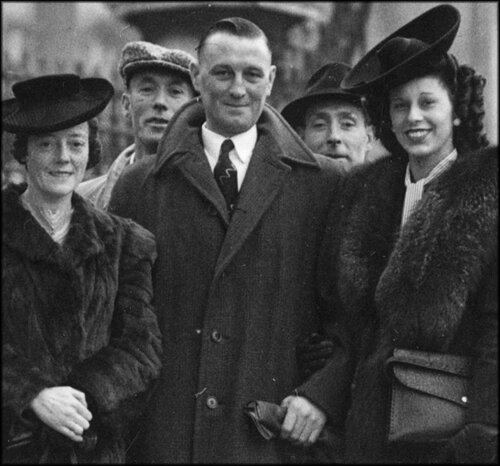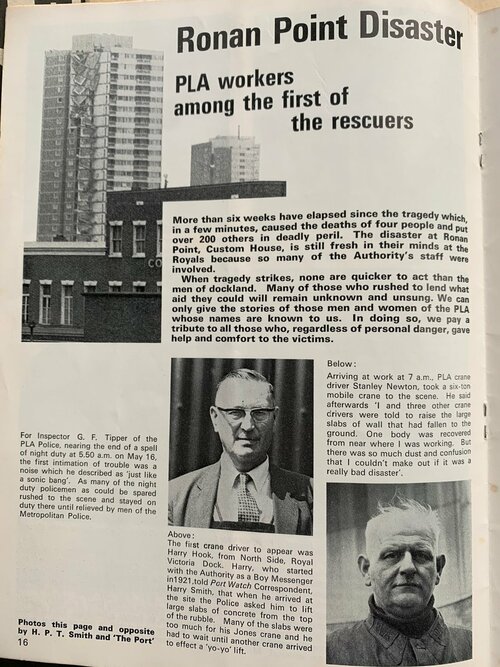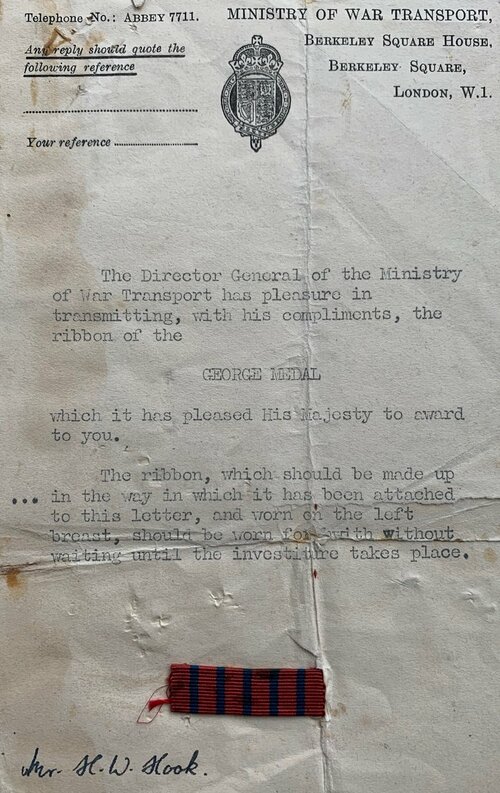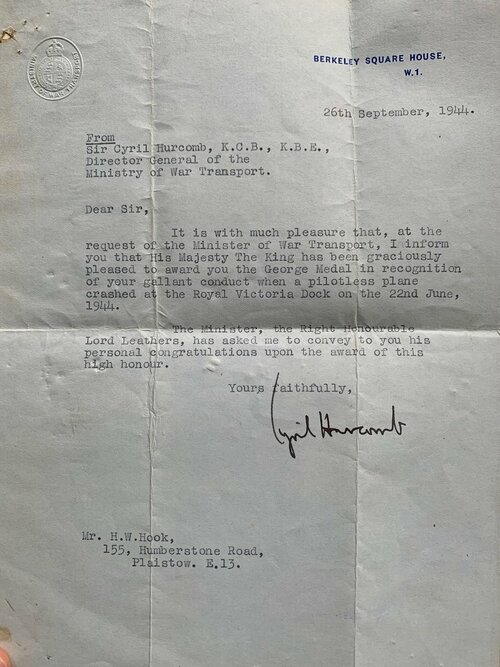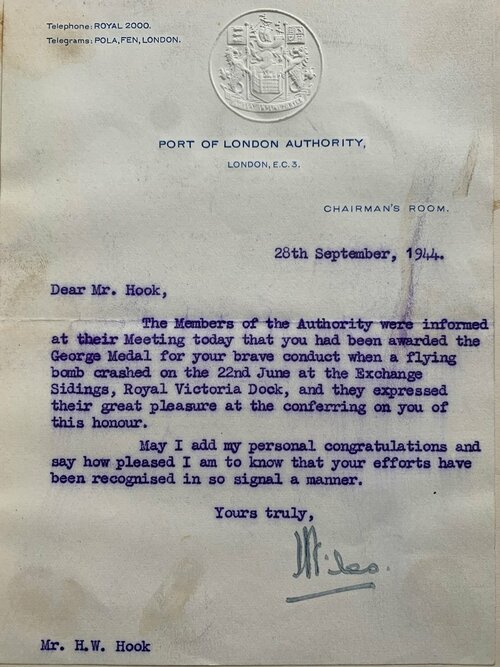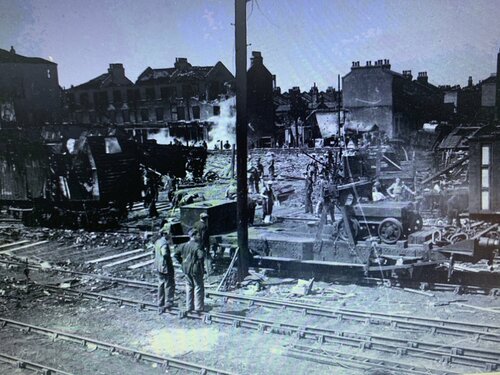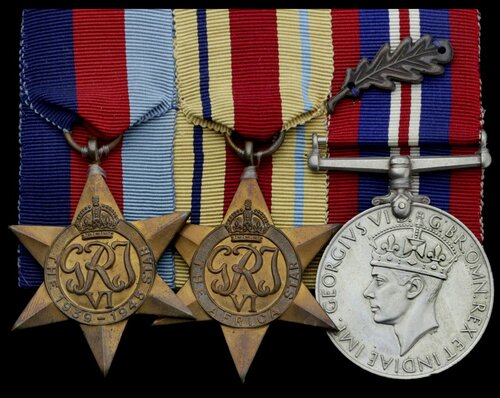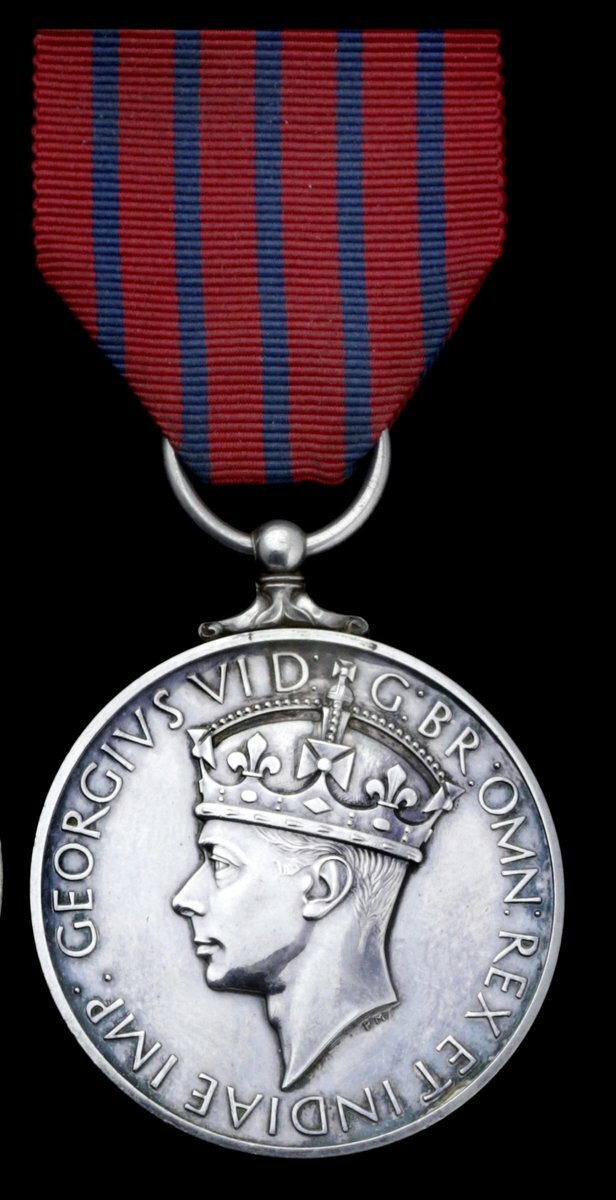Auction: 20003 - Orders, Decorations and Medals
Lot: 292
Family group:
A fine Second World War G.M. awarded to Henry Hook, a Port of London Authority employee who displayed great gallantry following a V.1 strike on the Royal Victoria Dock on 22 June 1944
George Medal, G.VI.R., 1st issue (Henry Walter Hook), extremely fine
A Second World War campaign group of three awarded to Lance-Bombardier R. E. Hook, Royal Artillery, who was killed in action in the battle of El Alamein in November 1942
1939-45 Star; Africa Star; War Medal 1939-45, M.I.D. oak leaf, extremely fine (4)
G.M. London Gazette 26 September 1944:
‘A flying bomb crashed near a very large number of rail trucks loaded with military stores, including ammunition, petrol and methylated spirits in metal containers. The locality became enveloped in smoke and fires broke out, burning debris falling on the trucks and setting light to the tarpaulin covers.
Hook crawled under a burning truck containing petrol in cans, uncoupled it and helped to move it so as to prevent the fire spreading. Then he noticed that debris was burning on the top of a tarpaulin covering the trucks loaded with ammunition. Climbing on to the truck he removed the burning debris and also, with help, the tarpaulin that had caught fire.
Hook completely disregarded the extreme danger of the situation and the risk to his safety. His initiative and promptness undoubtedly saved the trucks of ammunition and petrol from exploding and spreading the fire.’
The citation goes on to describe the bravery of Detective Inspector C. J. Tipper, of the Port of London Authority Police, who was awarded a B.E.M. on the same occasion.
Henry Walter “Harry” Hook was born in East Ham, London in May 1911 and joined the Port of London Authority on leaving school at the age of 14 years. He was to remain employed by the Authority for the remainder of his working life, being employed successively as a tally clerk, crane driver and docks’ foreman, mainly in the Royal Victoria Dock. As a result, he witnessed first hand the Blitz in 1940, when, in addition to working long hours in the docks, he served as an A.R.P. Warden and fire-watcher - the area was hit by almost continuous day and night raids over a 54 day period, and his own home among those damaged.
His subsequent G.M.-winning deeds in June 1944, as the V.1 menace arrived over London, are best described in Roger Perkins’ article Medals of the Crown (Crown Imperial magazine, December 1979):
‘On the morning of 22 June 1944, Harry Hook was standing, with a colleague, on a quay in the Royal Victoria Dock. They heard the familiar sound of a V1 flying bomb approaching from the south-east. Looking up, they saw the V1 crossing the river. At this moment the motor stopped and the missile immediately dived into the dock area. It passed over the heads of the two men, over the quayside buildings and crashed into the railway sidings beyond. The V1 carried 850kg. of explosive and the blast was violent. Mr. Hook and his friend were unhurt: they ran around the end of the warehouse and found several workmen on the ground, some dead, others badly injured. Harry Hook’s colleague stopped to give first aid to the casualties while he himself ran on toward the point of impact. The explosion had caused havoc amongst the congested rolling stock. The wagons had been blasted off the tracks and thrown up into tangled heaps. Several fires had broken out in the wrecked vehicles, small landing craft and military stores strewn around the area. Mr. Hook was the first rescuer to arrive and the first thing he saw was a railway wagon, loaded with cans of petrol, with its protective tarpaulin on fire. Crawling under the wagon, he managed to release the brake and push the wagon down the slight gradient so that it rolled away from the danger area.
More men started to arrive and to tackle the smaller fires. One problem which they could not handle was a line of closed railway wagons which had been blown onto its side and which was a mass of flames, the woodwork having caught fire. This was a job for the Fire Brigade and the tenders arrived after fifteen minutes. The firemen directed their hoses onto the blazing wagons but it was discovered that these particular wagons were loaded with ammunition packed in wooden crates, some of which had now caught fire, and the water was not penetrating to the interior of the wagons. Harry Hook volunteered to climb onto the sides of the over-turned wagons, going through the flames and smoke from one to another, opening the doors and enabling the firemen to aim their jets straight into the heaps of crated ammunition. The heat was intense and, to prevent his clothing from catching fire, he asked the firemen to play their hoses directly onto his back while he struggled with the locked doors. Their combined efforts were successful. If they had failed, if the fires had blazed out of control, the resulting explosion from the many tons of explosive would have devastated the docks and surrounding streets.’
Hook received his G.M. at an investiture at Buckingham Palace on 14 November 1944, in addition to a Port of London Authority Certificate of Gallantry, the latter being presented to him by the Prime Minister’s daughter, Subaltern Mary Churchill, A.T.S. Prior to his retirement in 1968, he witnessed one more notable emergency situation, this being the occasion when the block of flats at Ronan Point collapsed in the same year. Hook had been standing in the docks when he saw the side of the building start to fall, and immediately drove a mobile crane to the scene of the disaster, where he helped to lift concrete slabs clear of the injured.
Sold with a quantity of original documentation, including a red notebook with pasted-down letters regarding the award of the recipient’s G.M., among them Ministry of War Transport forwarding note with length of G.M. riband, and congratulatory letter from the Ministry’s Director-General, dated 26 September 1944, and similar messages from the Chairman and General Manager of the Port of London Authority, both dated 28 September 1944, several related newspaper cuttings, etc.; Buckingham Palace investiture letter, dated 31 October 1944, and related admittance ticket to the Palace, dated 14 November 1944, and group photograph outside the Palace gates, including Hook; Certificate of Membership for the Royal Society of St. George, dated 8 November 1944; together with later career correspondence including a letter from the Port of London Authority’s Director-General thanking him for his ‘prompt and valuable assistance’ at the time of the Ronan Point disaster in May 1968, a related newspaper report, and letter of retirement from the Authority’s Chairman, dated 4 October 1968, and a cassette recording of Hook discussing his career.
Ronald Ernest Hook, a brother of Henry Walter Hook, enlisted in the Royal Artillery in December 1939 and joined 68th Medium Regiment, R.A. in June 1940. He subsequently witnessed active service in the Middle East and the Western Desert, October 1940 to March 1941, and in Greece and Crete, March to May 1941, following which he returned to North Africa, where he joined 64th Medium Regiment, R.A. in August 1942. His unit having been allocated to the El Alamein push that November, Hook was mortally wounded by a mine on the 10th, dying two days later.
Sold with his original Mention in Despatches certificate, dated 13 January 1944, R.A. Record Office letter informing his next of kin that he had been wounded, and an old photograph of his grave in the El Alamein Cemetery.
Subject to 20% VAT on Buyer’s Premium. For more information please view Terms and Conditions for Buyers.
Sold for
£5,200
Starting price
£2800


